- Back to Home »
- Your first freeze? 5 ways to survive it
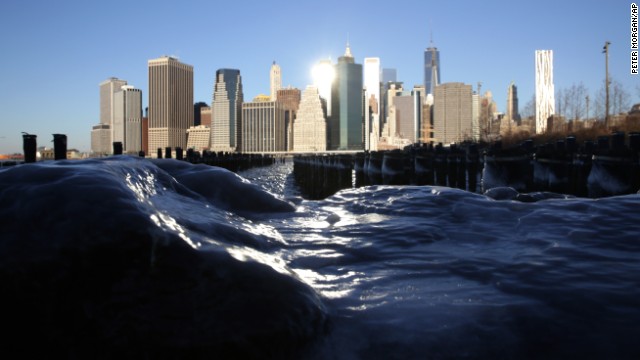 Ice forms around rocks on the Brooklyn waterfront, across from Lower Manhattan, on Tuesday, January 7, in New York City.
Ice forms around rocks on the Brooklyn waterfront, across from Lower Manhattan, on Tuesday, January 7, in New York City. 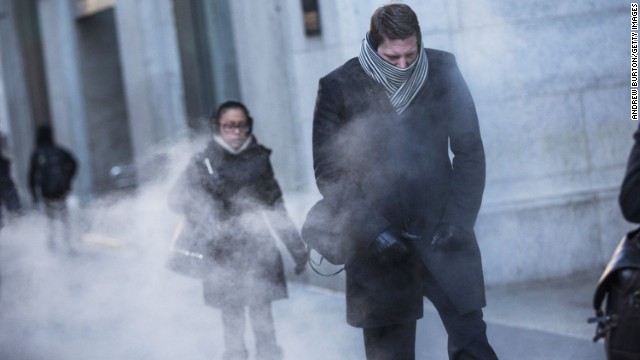 A man clenches his fists while walking past a steam vent in New York City on January 7.
A man clenches his fists while walking past a steam vent in New York City on January 7. 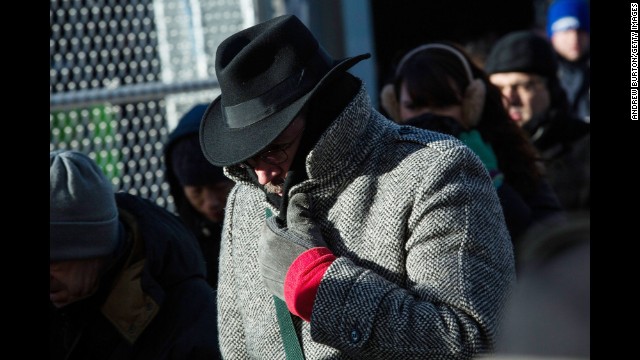 A man bundles up against the cold in New York City on January 7.
A man bundles up against the cold in New York City on January 7.  A couple walks past an advertisement in Pittsburgh during sub-zero temperatures January 7.
A couple walks past an advertisement in Pittsburgh during sub-zero temperatures January 7. 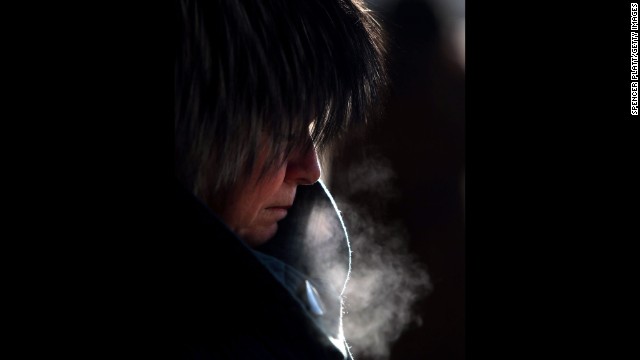 A woman tries to stay warm while waiting for a bus in Brooklyn, New York, on January 7.
A woman tries to stay warm while waiting for a bus in Brooklyn, New York, on January 7. 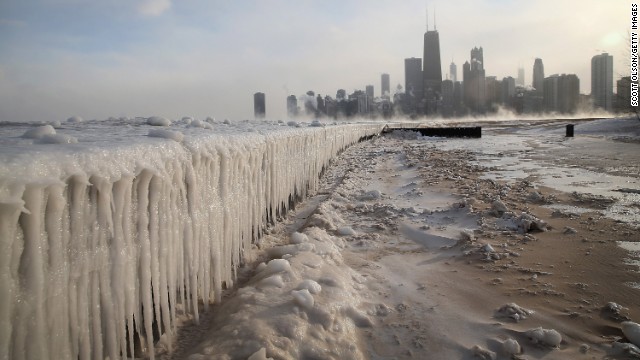 Ice builds up along Lake Michigan at Chicago's North Avenue Beach on Monday, January 6.
Ice builds up along Lake Michigan at Chicago's North Avenue Beach on Monday, January 6. 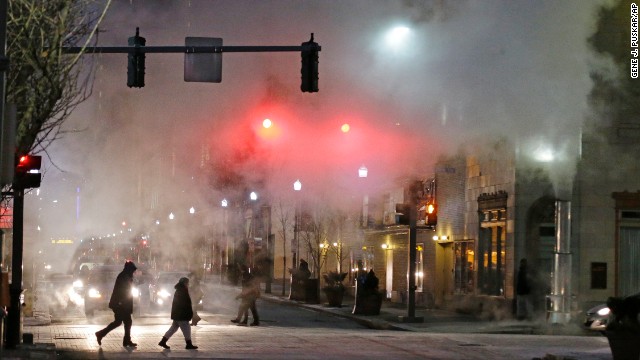 With temperatures nearing 0 degrees, a cloud of steam from a manhole blows across an intersection in downtown Pittsburgh on January 6.
With temperatures nearing 0 degrees, a cloud of steam from a manhole blows across an intersection in downtown Pittsburgh on January 6.  Men battle the bitter wind as they walk in Chicago on January 6.
Men battle the bitter wind as they walk in Chicago on January 6. 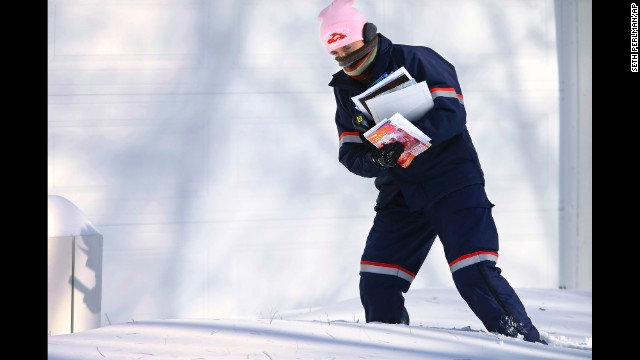 Postal worker Jamie Jasmon struggles to deliver mail in the snow January 6 in Springfield, Illinois.
Postal worker Jamie Jasmon struggles to deliver mail in the snow January 6 in Springfield, Illinois. 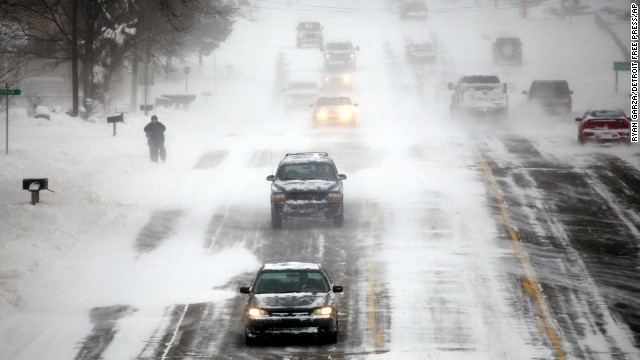 Vehicles drive down a snow-covered road in Burton, Michigan, on January 6.
Vehicles drive down a snow-covered road in Burton, Michigan, on January 6. 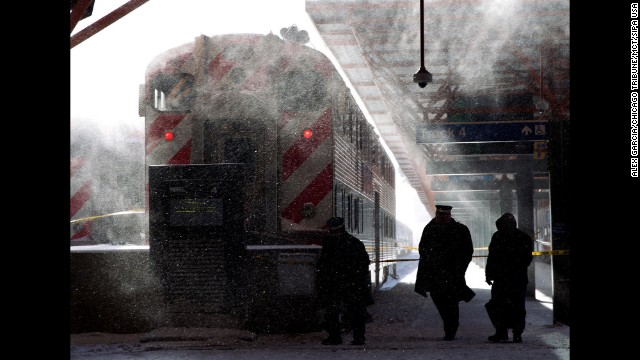 Metra employees in Chicago walk around LaSalle Street Station on January 6.
Metra employees in Chicago walk around LaSalle Street Station on January 6. 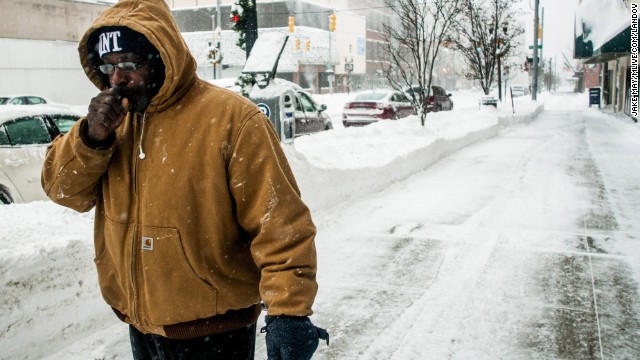 A man warms his hand while running errands in Flint, Michigan, on January 6.
A man warms his hand while running errands in Flint, Michigan, on January 6. 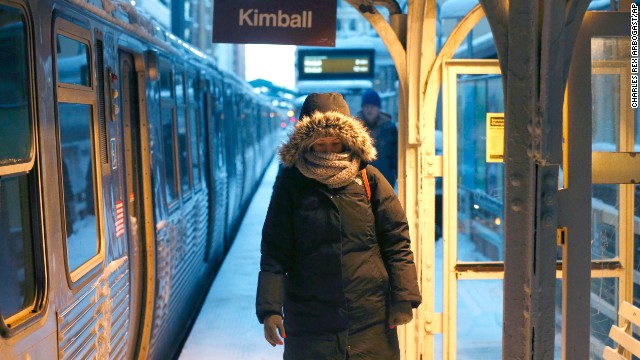 A commuter walks past warming lamps at a Chicago train station on January 6.
A commuter walks past warming lamps at a Chicago train station on January 6. 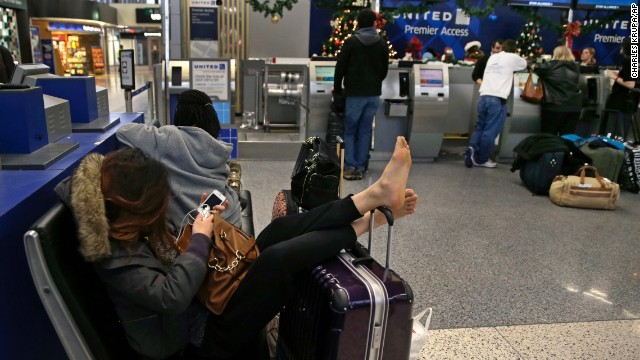 A woman props up her feet on her luggage January 6 after her flight home was canceled at Logan International Airport in Boston.
A woman props up her feet on her luggage January 6 after her flight home was canceled at Logan International Airport in Boston. 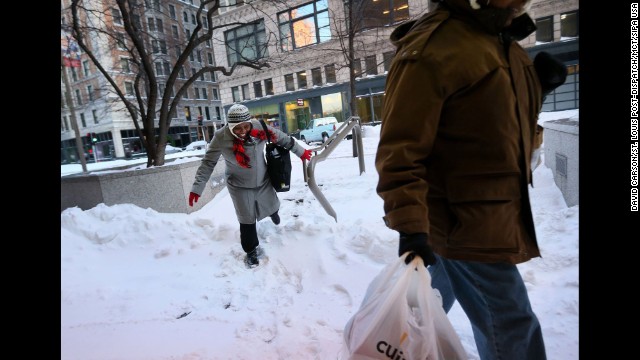 A woman makes her way through a snow drift in downtown St. Louis on January 6.
A woman makes her way through a snow drift in downtown St. Louis on January 6. 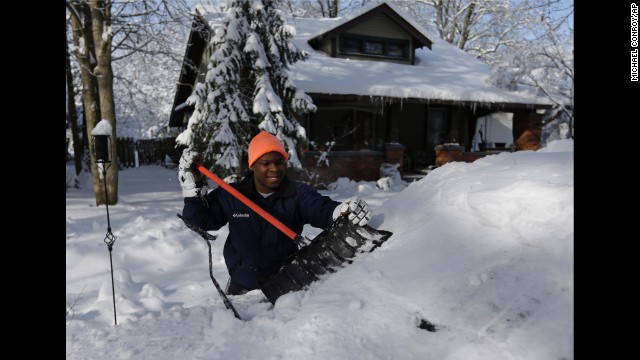 A man shovels the snow off his car in Indianapolis on January 6.
A man shovels the snow off his car in Indianapolis on January 6. 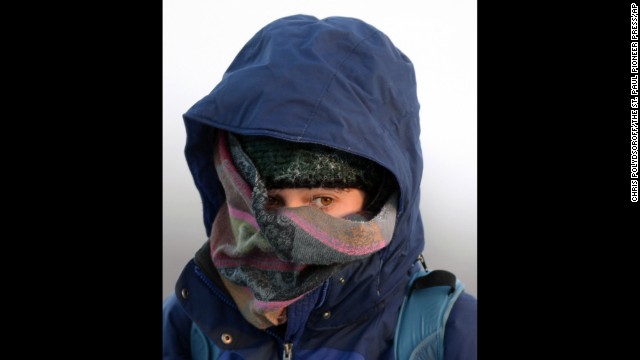 A woman walks to the University of Minnesota's St. Paul campus on January 6.
A woman walks to the University of Minnesota's St. Paul campus on January 6. 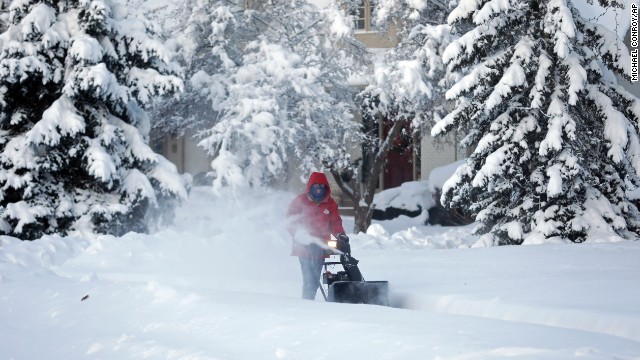 A man clears the sidewalk in front of his home in Carmel, Indiana, on January 6.
A man clears the sidewalk in front of his home in Carmel, Indiana, on January 6. 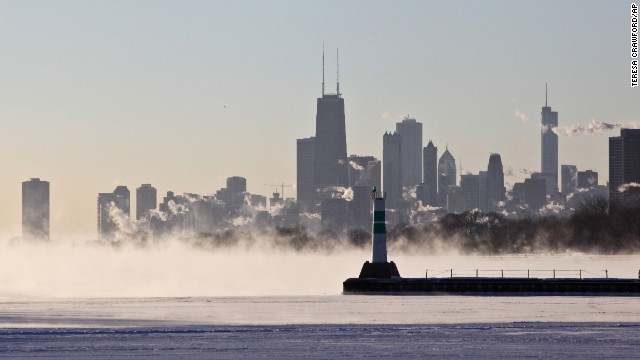 A blanket of fog covers Lake Michigan along the Chicago shoreline January 6.
A blanket of fog covers Lake Michigan along the Chicago shoreline January 6. 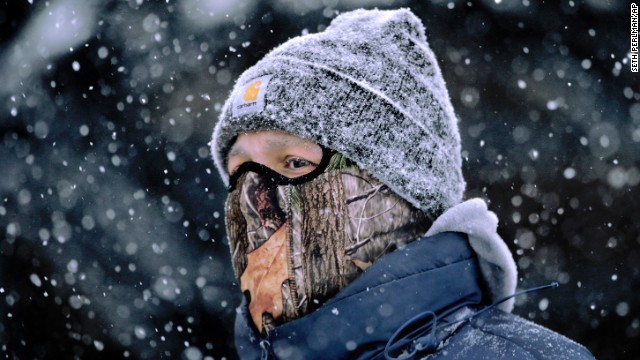 A man braves the snow in downtown Springfield as a winter storm moves across the Midwest on Sunday, January 5.
A man braves the snow in downtown Springfield as a winter storm moves across the Midwest on Sunday, January 5.  A car is buried in snow January 5 in Zionsville, Indiana.
A car is buried in snow January 5 in Zionsville, Indiana. 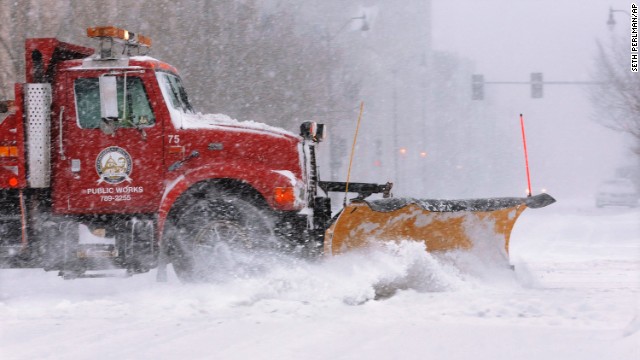 A city snowplow clears the street in an almost-deserted downtown Springfield on January 5.
A city snowplow clears the street in an almost-deserted downtown Springfield on January 5. 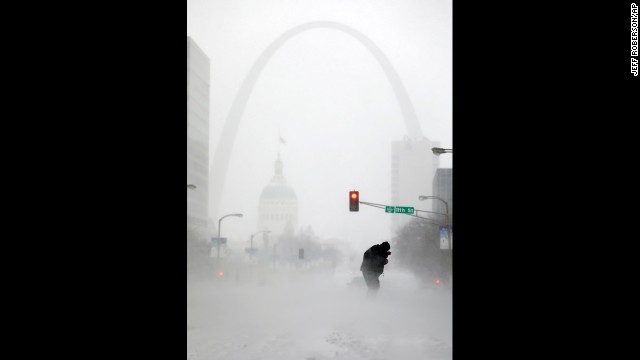 With the Gateway Arch in the distance, a person struggles to cross the street during a snowstorm January 5 in downtown St. Louis.
With the Gateway Arch in the distance, a person struggles to cross the street during a snowstorm January 5 in downtown St. Louis.  Snow covers a garden gnome in St. Louis on January 5.
Snow covers a garden gnome in St. Louis on January 5.  Anna Maksimkina of Yekaterinburg, Russia, sleeps on the floor at John F. Kennedy International Airport in New York after a Delta flight from Toronto to New York skidded off the runway into a snow bank, temporarily halting all flights January 5.
Anna Maksimkina of Yekaterinburg, Russia, sleeps on the floor at John F. Kennedy International Airport in New York after a Delta flight from Toronto to New York skidded off the runway into a snow bank, temporarily halting all flights January 5. 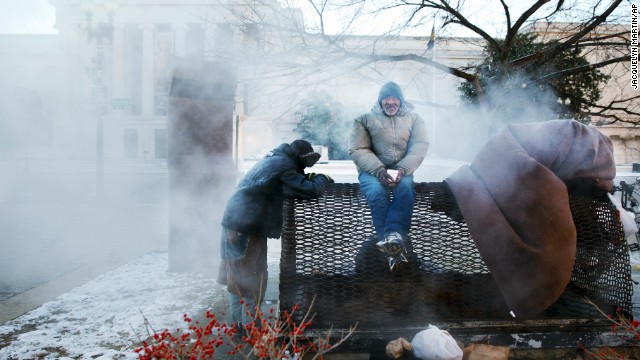 Four homeless men warm themselves on a steam grate by the Federal Trade Commission Building, blocks from the U.S. Capitol in Washington, as frigid temperatures grip the nation's capital on Saturday, January 4.
Four homeless men warm themselves on a steam grate by the Federal Trade Commission Building, blocks from the U.S. Capitol in Washington, as frigid temperatures grip the nation's capital on Saturday, January 4. 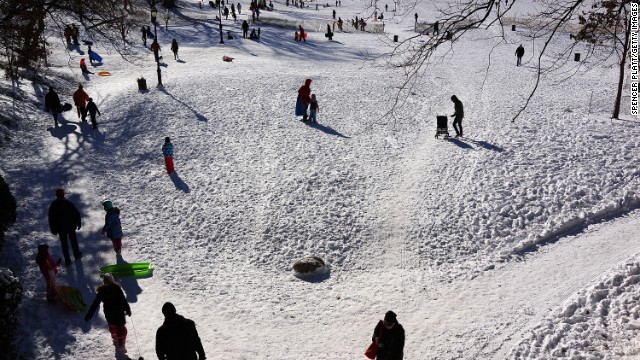 People go sledding in Prospect Park in Brooklyn, New York, on January 4.
People go sledding in Prospect Park in Brooklyn, New York, on January 4. 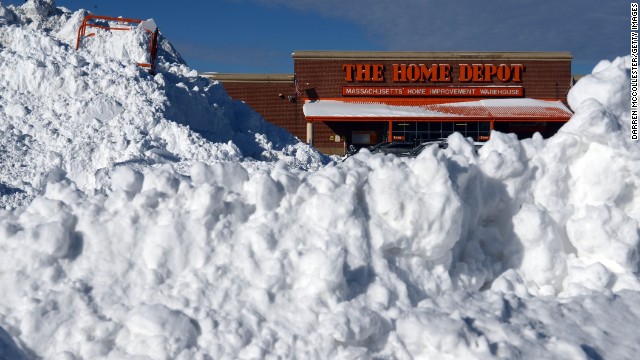 Snow is piled high in front of a Home Depot in Boston on January 4.
Snow is piled high in front of a Home Depot in Boston on January 4. 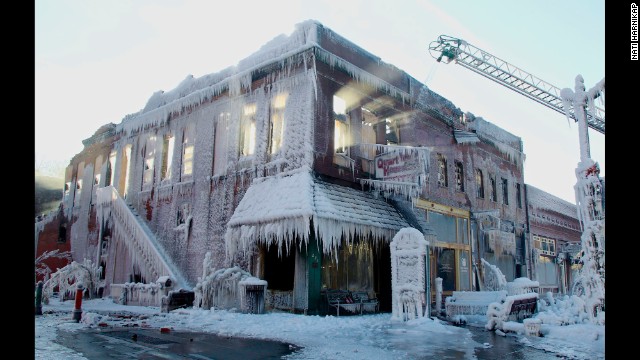 Sunlight beams through the windows of a building that caught on fire Friday, January 3, in Plattsmouth, Nebraska. The firefighters' water froze all over the building.
Sunlight beams through the windows of a building that caught on fire Friday, January 3, in Plattsmouth, Nebraska. The firefighters' water froze all over the building. 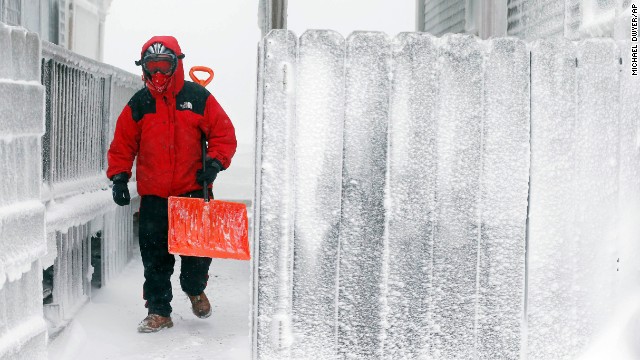 Michael Stanton walks between houses covered with ice in Scituate, Massachusetts, on January 3.
Michael Stanton walks between houses covered with ice in Scituate, Massachusetts, on January 3. 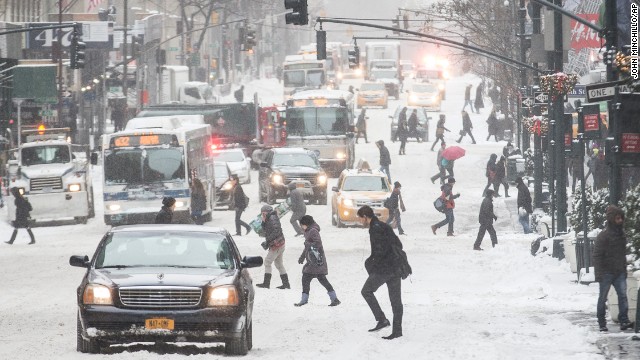 Pedestrians brave wind and snow as they cross New York City's Fifth Avenue on January 3.
Pedestrians brave wind and snow as they cross New York City's Fifth Avenue on January 3. 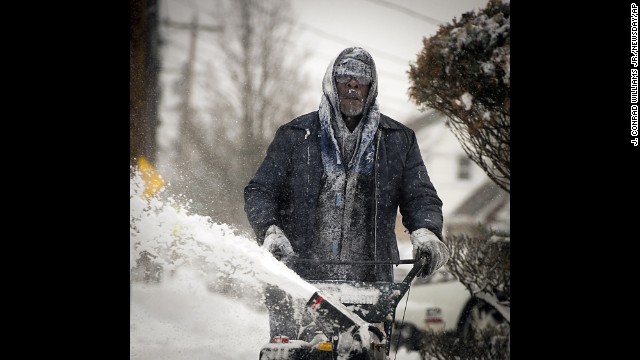 Snow clings to the clothing and facial hair of Jerome Williams as he uses a snowblower in front of his home in Roosevelt, New York, on January 3.
Snow clings to the clothing and facial hair of Jerome Williams as he uses a snowblower in front of his home in Roosevelt, New York, on January 3. 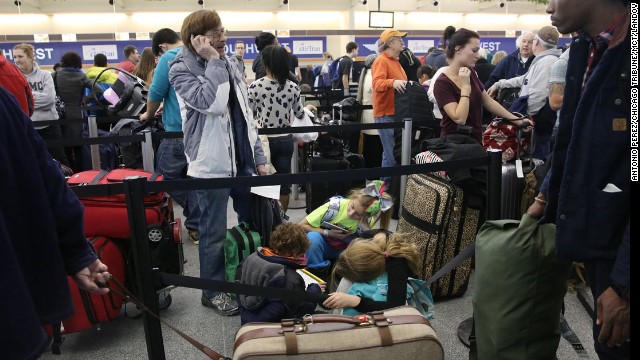 Travelers wait in line January 3 at Chicago Midway International Airport.
Travelers wait in line January 3 at Chicago Midway International Airport. 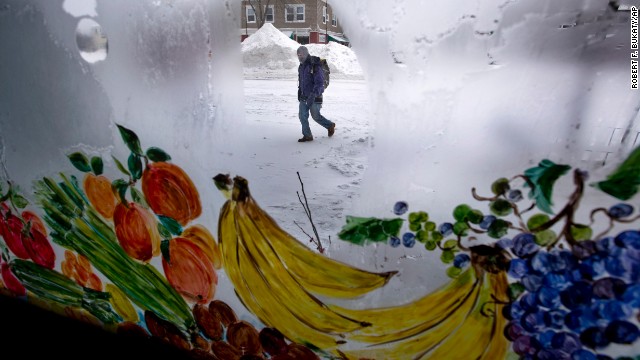 Frost covers the windows at the Morning Glory natural food store in Brunswick, Maine, on January 3.
Frost covers the windows at the Morning Glory natural food store in Brunswick, Maine, on January 3.  Snowplows clear snow from one of the runways at JFK Airport on January 3.
Snowplows clear snow from one of the runways at JFK Airport on January 3. 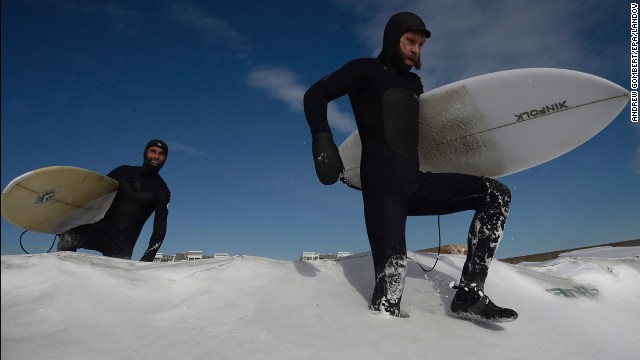 Surfers make their way through snow on New York's Rockaway Beach on January 3.
Surfers make their way through snow on New York's Rockaway Beach on January 3.  Passengers wait in line at a security checkpoint at JFK Airport on January 3.
Passengers wait in line at a security checkpoint at JFK Airport on January 3. 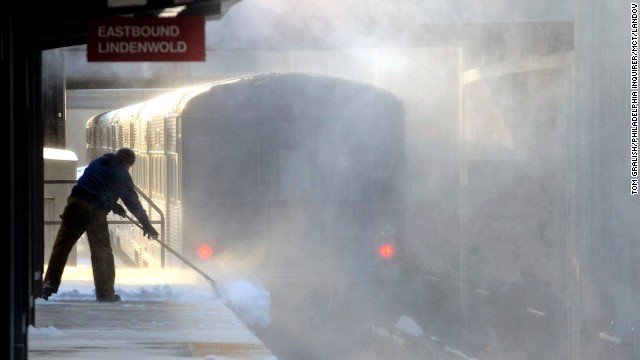 Blowing snow swirls as a worker shovels a platform at a Haddonfield, New Jersey, train station on January 3.
Blowing snow swirls as a worker shovels a platform at a Haddonfield, New Jersey, train station on January 3.  A plane takes off January 3 as trucks plow snow at Newark Liberty International Airport in Newark, New Jersey.
A plane takes off January 3 as trucks plow snow at Newark Liberty International Airport in Newark, New Jersey. 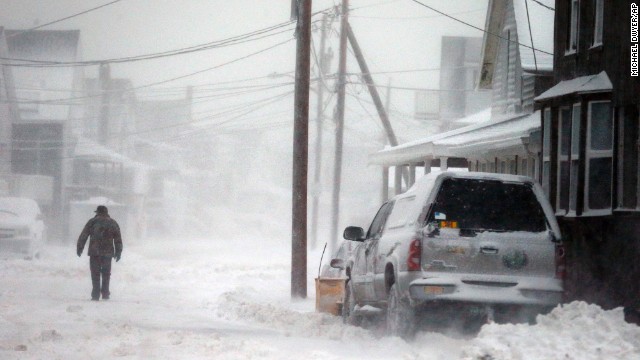 A man walks down a snowy road along the shore in Scituate on January 3.
A man walks down a snowy road along the shore in Scituate on January 3. 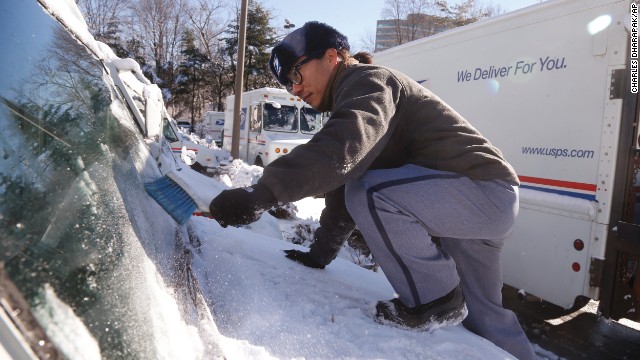 Postal worker Danny Kim clears snow and ice off the hood of his delivery truck January 3 in Bethesda, Maryland.
Postal worker Danny Kim clears snow and ice off the hood of his delivery truck January 3 in Bethesda, Maryland. 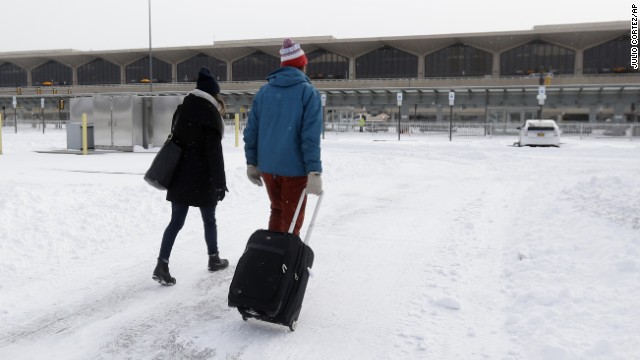 A couple walks across a snow-covered parking lot January 3 at Newark Liberty International Airport.
A couple walks across a snow-covered parking lot January 3 at Newark Liberty International Airport.  Tourists play in the snow at the base of the Washington Monument on January 3.
Tourists play in the snow at the base of the Washington Monument on January 3. 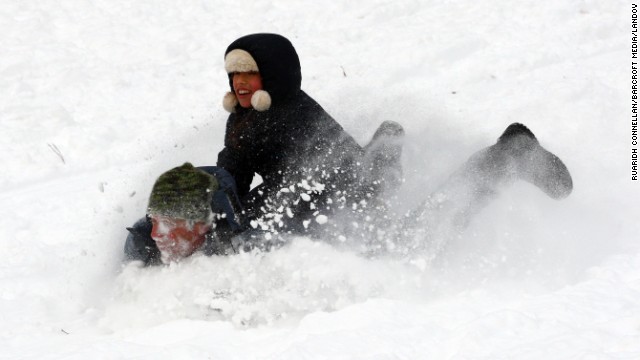 People play in Brooklyn's Prospect Park on January 3.
People play in Brooklyn's Prospect Park on January 3. 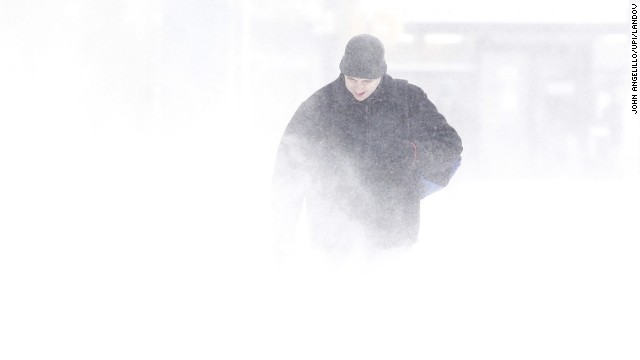 A man walks through the snow as the wind kicks it up January 3 in New York City.
A man walks through the snow as the wind kicks it up January 3 in New York City. 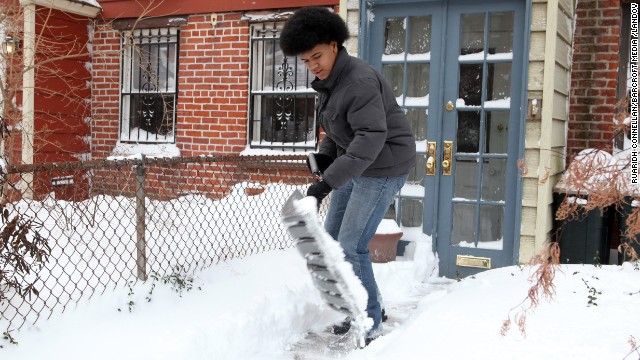 Dante de Blasio, son of New York Mayor Bill de Blasio, shovels snow outside his home in Brooklyn on January 3.
Dante de Blasio, son of New York Mayor Bill de Blasio, shovels snow outside his home in Brooklyn on January 3.  Snow covers subway rails in New York City on January 3.
Snow covers subway rails in New York City on January 3. 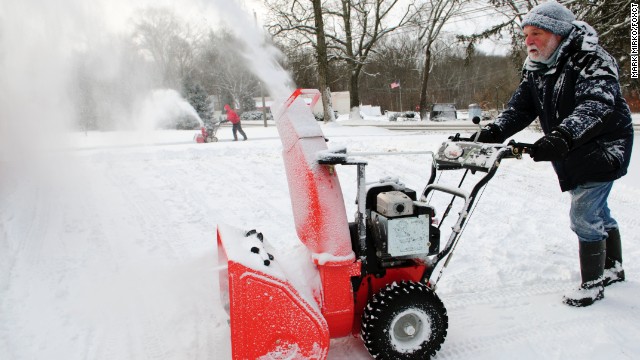 A man uses his snowblower to clear some paths in Mansfield, Connecticut, on January 3.
A man uses his snowblower to clear some paths in Mansfield, Connecticut, on January 3. 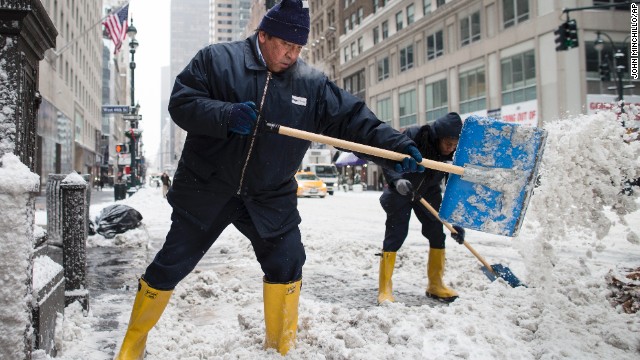 Workers clear snow off sidewalks on New York City's Fifth Avenue on January 3.
Workers clear snow off sidewalks on New York City's Fifth Avenue on January 3.  A man clears snow from a vehicle January 3 in Albany, New York.
A man clears snow from a vehicle January 3 in Albany, New York. 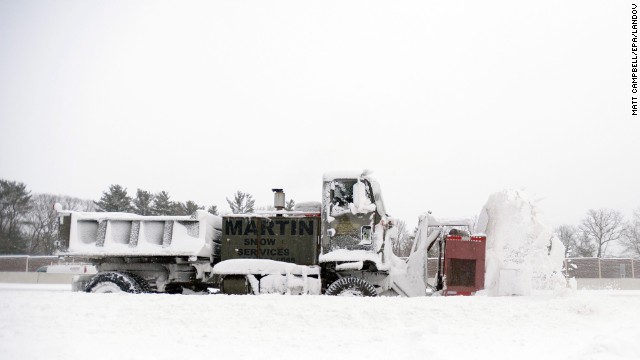 A truck-mounted snowblower clears a section of road in Dedham, Massachusetts, on January 3.
A truck-mounted snowblower clears a section of road in Dedham, Massachusetts, on January 3.  A worker clears snow from a subway station in Queens, New York, on January 3. Public schools were closed Friday after up to 7 inches of snow fell in New York City.
A worker clears snow from a subway station in Queens, New York, on January 3. Public schools were closed Friday after up to 7 inches of snow fell in New York City. 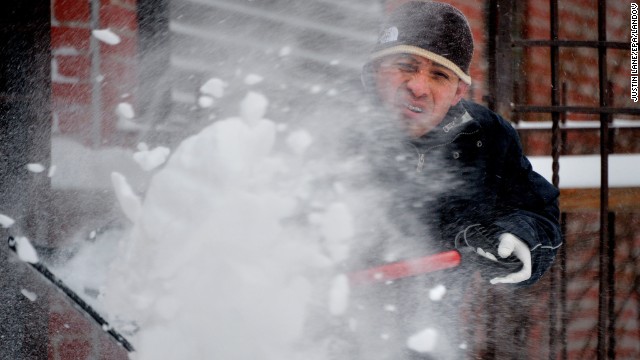 A man shovels snow during the tail end of a snowstorm in Brooklyn on January 3.
A man shovels snow during the tail end of a snowstorm in Brooklyn on January 3. 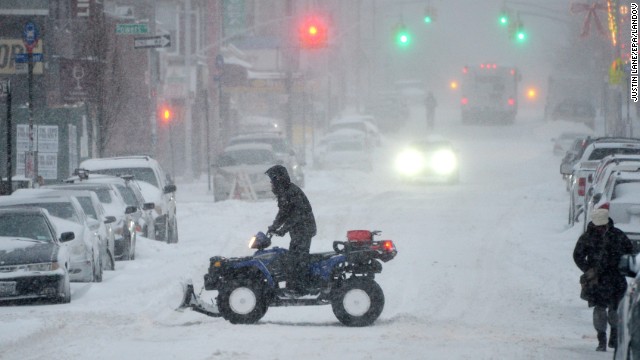 A man rides an all-terrain vehicle through a Brooklyn street on January 3.
A man rides an all-terrain vehicle through a Brooklyn street on January 3. 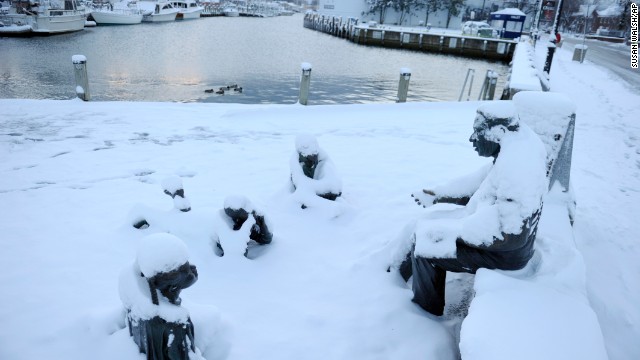 The Kunta Kinte-Alex Haley Memorial is covered in snow in Annapolis, Maryland, on January 3.
The Kunta Kinte-Alex Haley Memorial is covered in snow in Annapolis, Maryland, on January 3. 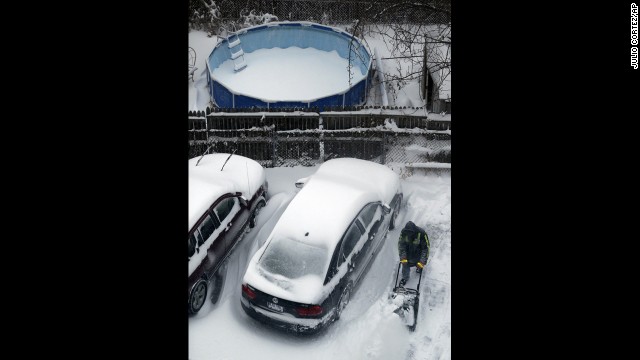 A man plows snow January 3 following an overnight snowstorm in Jersey City, New Jersey.
A man plows snow January 3 following an overnight snowstorm in Jersey City, New Jersey. 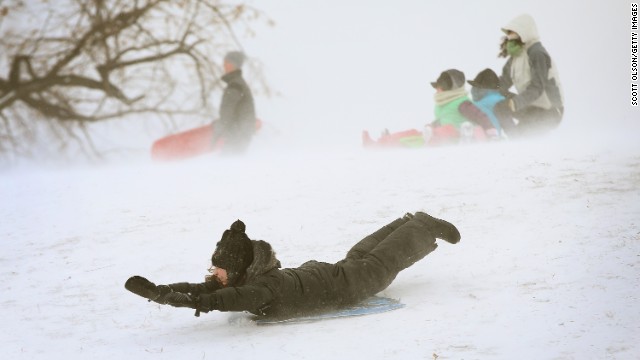 A child sleds down a hill in Chicago's Humboldt Park on Thursday, January 2.
A child sleds down a hill in Chicago's Humboldt Park on Thursday, January 2. 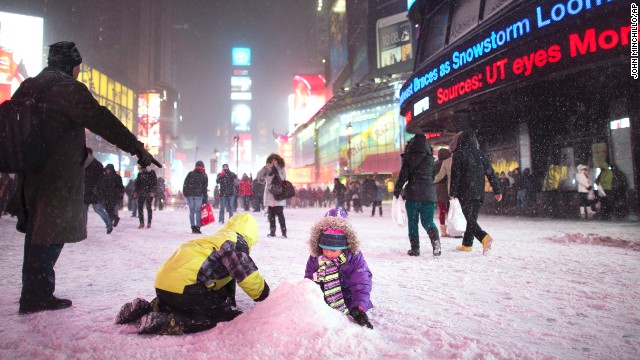 Children make a snow pile in New York's Times Square on January 2.
Children make a snow pile in New York's Times Square on January 2. 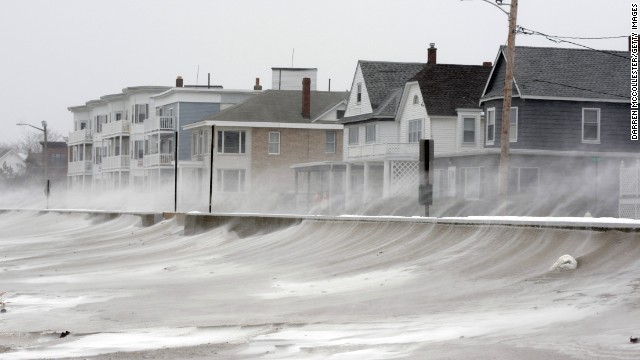 Winds whip snow from the beach across Winthrop Shore Drive in Winthrop, Massachusetts.
Winds whip snow from the beach across Winthrop Shore Drive in Winthrop, Massachusetts. 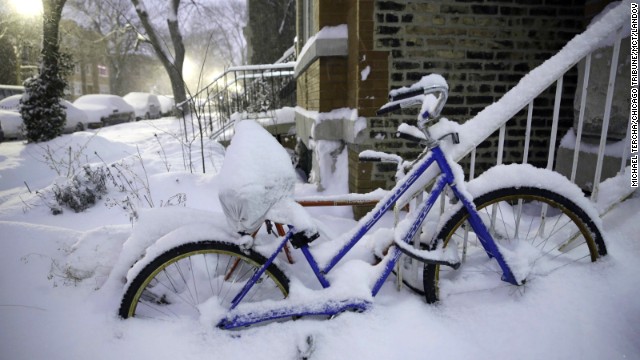 Snow covers bikes along Leavitt Street in Chicago's Wicker Park on January 2.
Snow covers bikes along Leavitt Street in Chicago's Wicker Park on January 2. 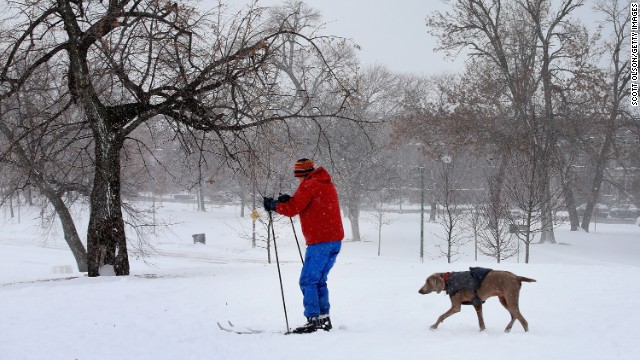 With his dog in tow, a man skis across heavy snow in Humboldt Park on January 2.
With his dog in tow, a man skis across heavy snow in Humboldt Park on January 2. 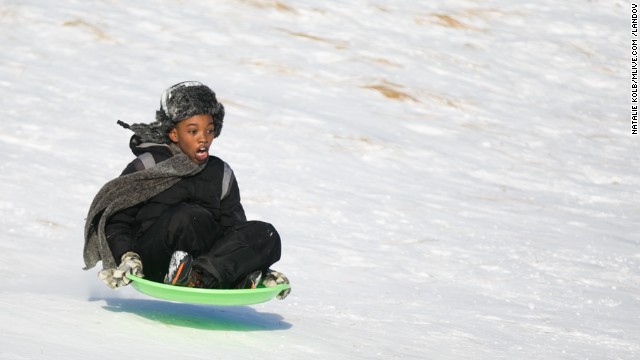 Dallas Todd, 11, flies down a snowy hill at Lake Harbor Park in Norton Shores, Michigan, on January 2.
Dallas Todd, 11, flies down a snowy hill at Lake Harbor Park in Norton Shores, Michigan, on January 2. 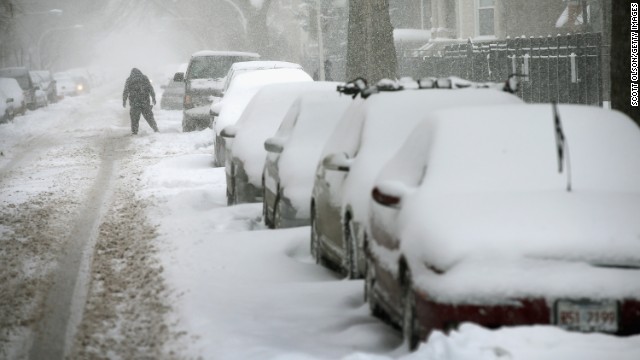 Snow covers cars in Chicago's Humboldt Park neighborhood on January 2.
Snow covers cars in Chicago's Humboldt Park neighborhood on January 2. 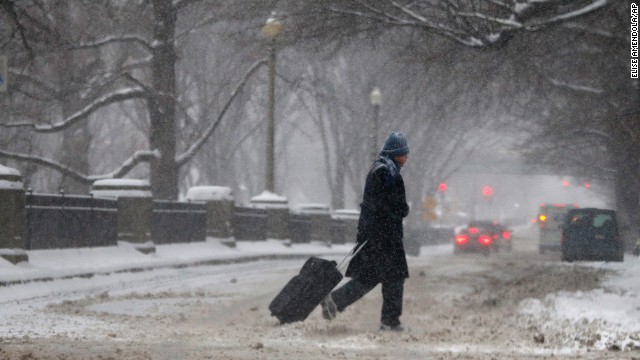 A man drags a suitcase on a snowy street in downtown Boston on January 2.
A man drags a suitcase on a snowy street in downtown Boston on January 2. 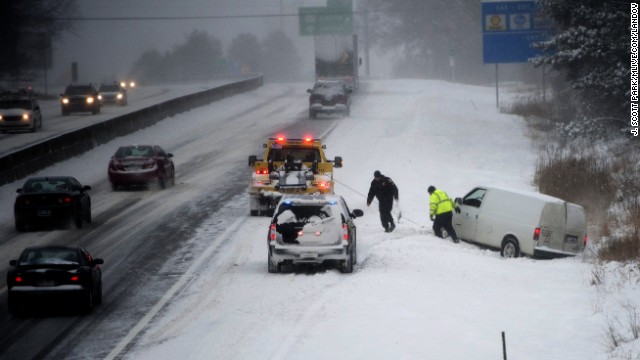 A van is pulled from a ditch along Interstate 94 in Jackson, Michigan, on January 2.
A van is pulled from a ditch along Interstate 94 in Jackson, Michigan, on January 2. 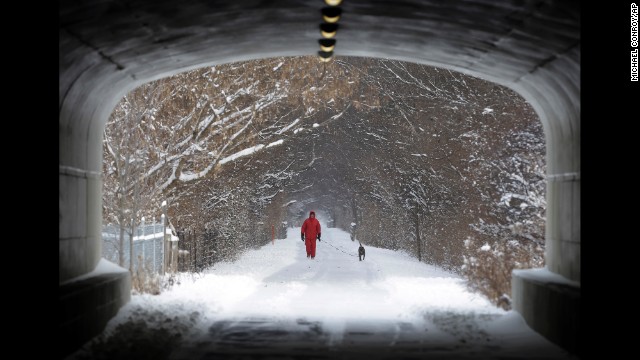 A man walks his dog on the snow-covered Monon Trail in Carmel, Indiana, on January 2.
A man walks his dog on the snow-covered Monon Trail in Carmel, Indiana, on January 2. 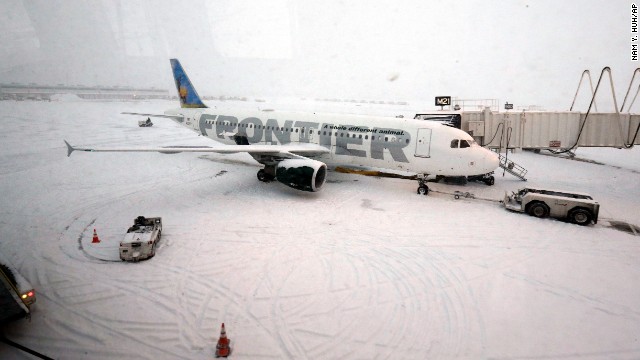 An airplane waits for passengers at O'Hare International Airport in Chicago on January 2.
An airplane waits for passengers at O'Hare International Airport in Chicago on January 2. 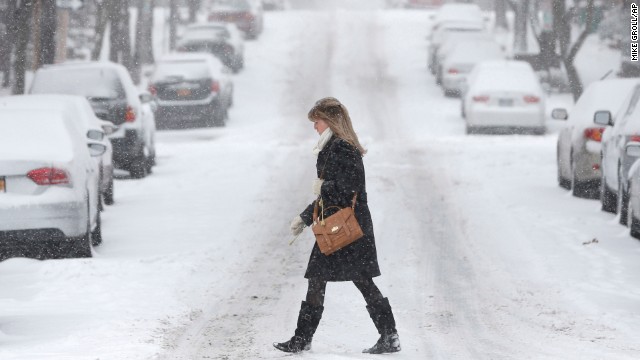 A woman walks through snowy conditions in Albany on January 2.
A woman walks through snowy conditions in Albany on January 2. 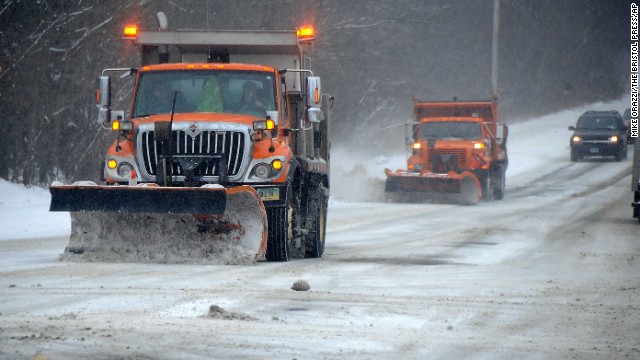 Trucks clear snow off the roads in Torrington, Connecticut, on January 2.
Trucks clear snow off the roads in Torrington, Connecticut, on January 2. 
1

2

3

4

5

6

7

8

9

10

11

12

13

14

15

16

17

18

19

20

21

22

23

24

25

26

27

28

29

30

31

32

33

34

35

36

37

38

39

40

41

42

43

44

45

46

47

48

49

50

51

52

53

54

55

56

57

58

59

60

61

62

63

64

65

66

67

68

69
- Charles Bryant: If you're not used to polar vortex-type weather, here are some tips
- He says respect wind chill; exposed skin can lead to frostbite or worse
- He says if symptoms of hypothermia, get warmed up, stay calm, share body heat
- Bryant: Wear hat, hydrate (no alcohol), and if you lose power build fire (think safely)
Editor's note: Charles W. (Chuck) Bryant is the co-host, with Josh Clark, of Discovery Channel's 'Stuff You Should Know.' The pair has released nearly 600 episodes of their award-winning show since 2008.
(CNN) -- If you're from, say, the Midwest or Northeast or Alaska, dealing with the cold is not only a way of life, but also a point of pride: You can take care of yourself, and you're not shy about pointing it out. But, as evidenced by this week's "polar vortex," cold weather can barrel through many parts of the country — Georgia, Florida, Arkansas — where people aren't used to sub-freezing temperatures.
There are some true life-threatening scenarios, like a car breaking down on a rural stretch of wintery road (always pack a blanket), but it can be dangerous even in your own home if you're caught without the necessities you need to keep warm, and this is especially true for the elderly.
If you're in a part of the United States new to this kind of severe weather, here are some suggestions to help you help yourself.

1: Wind chill can kill
Wind chill is the effect of moving air on exposed skin, a term coined by Antarctic explorer Paul Siple in the late 1930s to help describe how wind figures into heat loss. He experimented with wind chill's effect by timing how long it took to freeze water in varying degrees of wind strength. If you're not used to bitter wind chill, realize that you need to take it seriously when preparing for any outdoor activities. Skin exposed for five minutes in below-zero wind chill conditions can get frostbite. Longer can do worse.
Two University of California at Berkeley economists found that deaths related to cold reduced the average life expectancy of Americans by a decade, if not more. In countries where people were exposed to 10 or fewer days a year, the death rate was substantially higher than in countries with at least 90 cold days a year.
Additionally, cold weather can leave us without our thinking caps, willing to do whatever it takes to warm up. This can indirectly lead to unexpected fatalities because of accidents relating to carbon monoxide poisoning and house fires.
2: Hypothermia and layering
Hypothermia -- when your body temperature falls to 95 degrees F -- is a grim possibility if you're facing the cold without power, and layering your clothing is your best first defense against it. If you're experiencing slurred speech, stiff joints, a loss of coordination, uncontrollable shivering, loss of bladder control, puffy face or mental confusion, you could be suffering from hypothermia, which can be fatal. To combat this, get yourself into a warmer environment as soon as you can. Cover yourself with any items you can find -- blankets, sleeping bags, pillows. Just as you layer your upper body clothing, you should also layer what you have on your feet. Try a thin pair of nylon, silk or wool socks for starters -- then layer with additional wool socks. If you think a loved one is suffering from hypothermia, you should handle that person with great care, as the condition could make it easy for him or her to go into cardiac arrest.
Keep them horizontal and calm, and reassure them that they're going to be fine. Use each other's body heat to warm up by getting into a sleeping bag together or simply hugging each other tight to create warmth. And, of course, seek medical attention as soon as possible.
3: Wear a hat, despite the myth
 Winter weather trumps travel
Winter weather trumps travel  Florida farmers fear crop freeze
Florida farmers fear crop freeze 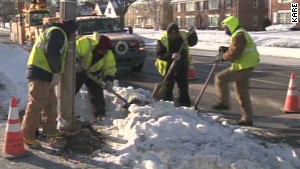 Workers brave bitter cold
Workers brave bitter cold You've probably heard the popular myth that you lose most of your body heat through your head. This myth was perpetuated by an outdated U.S. Army survival training manual that stated that 40% to 50% of our body heat is lost through the head. The truth is, you lose the same amount of heat through your head as you would any part of your body that is exposed to the elements However, you're way more likely to go out into the cold without a warm hat, than say, a shirt or a pair of shoes. But just because you don't lose more heat through your head doesn't mean you should leave your winter hat on the rack. Wearing a touque is a great way to assist your heavy coat, gloves, boots and snow pants in keeping all of you warm. Think of it as capping off your winter clothing plan.
4: Keep Hydrated
Hydration isn't just a warm weather worry. Many people forget that you need water in the freezing cold just as much as you do in hot weather. If your pipes are frozen, eating some snow or ice may seem like a great idea, but it will lower your core temperature and actually bring on dehydration. You can melt the snow or ice, but remember that while it can be safe to ingest in more remote locations, drinking water from melted "city snow" is a risk. You'll also want to avoid drinking only coffee or alcohol as a warming technique. I know this one is tough to resist since it may give you a short-term warm up, but it'll dehydrate you much more quickly. If you must indulge, remember to also drink plenty of water along with your coffee or toddy.
5: Light Your Fire
A fire is the best way to fight a winter chill if you're stuck in your home without power. And this means only fireplaces. You should never use your gas oven or stove to warm up under any circumstances as it could lead to carbon monoxide poisoning. But if you have a fireplace or a kerosene heater you're in luck. Use your fireplace as your main heat source, and if you can, sleep in the room with it — just not too close and with a protective fire screen. The last thing you want to do is wake up to find that fire has moved from the fireplace to your living room carpet.
If this vortex leaves you worried that winters could be severe in your part of the country from now on, before the next one, make sure you have a nice stockpile of wood, as it will be tougher to find once a storm hits, and outages can last days or weeks depending on how severe the weather is and how competent our utility company is in restoring power.
And here's a new summer task to consider: Make sure your chimney is clear and clean before the chimney sweeps are all booked up — and the next vortex swoops down from the north.
Follow us on Twitter @CNNOpinion.
Join us on Facebook.com/CNNOpinion.
The opinions expressed in this commentary are solely those of Charles Bryant







